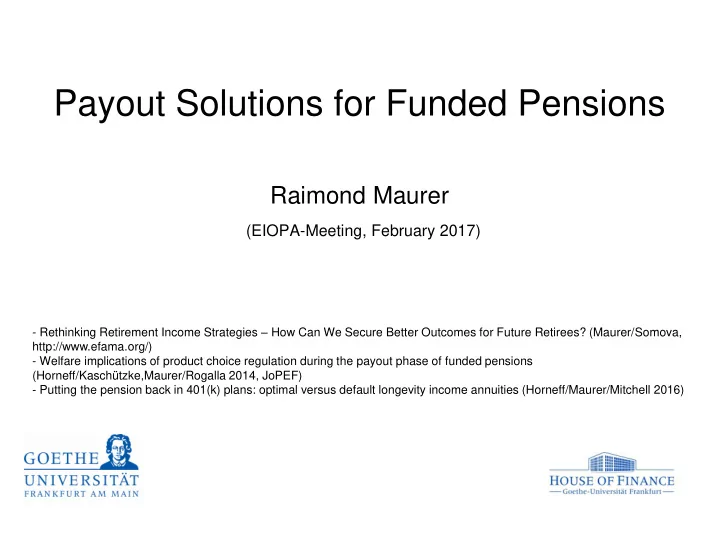

Payout Solutions for Funded Pensions Raimond Maurer (EIOPA-Meeting, February 2017) - Rethinking Retirement Income Strategies – How Can We Secure Better Outcomes for Future Retirees? (Maurer/Somova, http://www.efama.org/) - Welfare implications of product choice regulation during the payout phase of funded pensions (Horneff/Kaschützke,Maurer/Rogalla 2014, JoPEF) - Putting the pension back in 401(k) plans: optimal versus default longevity income annuities (Horneff/Maurer/Mitchell 2016)
Motivation With $5 trillions invested in defined contribution pension plans, “many retirees face the daunting task of determining an appropriate spending and investment strategy for their accumulated savings”. Prof. William Sharpe 2007 Meeting of the Wharton Pension Research Council. What are basic risk categories? • Investment risk, longevity risk, inflation risk, credit risk Who stands to help retirees managing their money in retirement? • Life insurers offering payout life annuities ( pooled solutions ); • Asset managers offering systematic drawdown plans ( non-pooled solutions ); • Integrated products using both What is the role of the state as a regulator? • Regulate product quality and product choice (mandatory annuitization?) • Ensure steady tax income 2
Basic types of payout solutions for funded pensions Pooled solutions (life annuities): o Idea : Transfer retirement assets into a lifelong income stream o Types : Fixed-, participating-, investment linked-, immediate-, deferred annuity Pro: (Guaranteed) lifelong income and “survival credit” o o Con: Low flexibility & liquidity, no bequest & control over retirement assets, credit risk Non-pooled solutions (drawdown plans): o Idea : Keep retirement assets in mutual funds and make periodic withdrawals o Types: Asset Allocation (stocks, bonds, balanced), Payout rules: 4% p.a., 1/LE) o Pro: High liquidity & flexibility, bequest and control over assets Con: No “survival credit” ; could (but not must) be subject to longevity-/investment risk o Integrated Solutions (drawdown plan + annuities) o Partial annuitization at retirement o Dynamic (gradual) annuitization o Deferred annuitization (Longevity Income Annuity) at advanced age (e.g 85) are cheap and effective instruments to protect against longevity risk; US 401(k) plans; German Riester plans Lump sum payments 3
Optimal retirement strategy – integrated solutions can over higher benefits while having efficient risk controls Economic research (household finance) on optimal retirement strategies shows the importance to consider the interaction between life annuities and drawdowns (including equity stock positions) during whole retirement period. Determinants of optimal payout strategies: Pre-existing lifelong retirement income (i.e. state pension), accumulated funds, health & family status. Regulation of product choice: o Economic costs of mandatory (full) annuitization could be very high (low interest rates; preferences, individual needs) o Allowing longevity income annuities (e.g. at age 85) as default solutions It is difficult for the average retiree to implement an optimal retirement strategy without professional help (advice and/or cost-efficient integrated products) Default solutions (opting out) are important and welfare enhancing 4
Next steps ……. Part 1: Characteristics of payout solutions Part 2: Economic modelling of optimal payout solutions and international experiences Part 3: Implications for products (default options; regulation; advice) 5
Some literature “ Asset Allocation and Location over the Life Cycle with Survival-Contingent Payouts ”, (Horneff/Maurer/Mitchell/Stamos) in: Journal of Banking and Finance 33, 2009, 1688-1699 “ Optimal Gradual Annuitization: Quantifying the Costs of Switching to Annuities”, (Horneff/Maurer/Stamos), in: Journal of Risk and Insurance 75, 2008, 1019-1038. “Life -Cycle Asset Allocation with Annuity Markets” (Horneff/Maurer/Stamos), in: Journal of Economic Dynamics and Control 32, 2008, 3590-3612 “Following the Rules: Integrating Asset Allocation and Annuitization in Retirement Portfolios” (Horneff/Maurer/Mitchell/Dus), in: Insurance: Mathematics and Economics 42, 2008, S. 396-408 “Deferred Annuities and Dynamic Portfolio Choice (Horneff/Maurer/Rogalla) in: Journal of Banking and Finance 34, 2010, 2652 –2664” “Variable Payout Annuities and Dynamic Portfolio Choice in Retirement (Horneff/Maurer/Mitchell/Stamos) in: Journal of Pension Economics and Finance 9, 2010, 163-183. “Optimal Portfolio Choice over the Life -Cycle with Flexible Work, Endogenous Retirement, and Lifetime Payouts ” (Chai/Horneff/Maurer/ Mitchell) in: Review of Finance 15, 2011, 875-907. “Optimal Portfolio Choice with Annuities and Life Insurance for Retired Couples”(Hubener/Maurer/Rogalla ) in: Review of Finance 18, 2014, 147-188. “Lifecycle Portfolio Choice With Systematic Longevity Risk and Variable Investment - linked Deferred Annuities” (Maurer/Mitchell/Rogalla /Kartashov) in: Journal of Risk and Insurance 80, 2013, 649-676 (also NBER WP 17505) “Participating Payout Life Annuities: Lessons from Germany” (Maurer/Rogalla/Siegelin) in: ASTIN-Bulletin 43, 2/2013, 159-197. “Welfare Implications of Product Choice Regulation during the Payout Phase of Funded Pensions (Horneff/Kaschützke/Maurer/Rogalla) in: Journal of Pension Economics and Finance 13, 2014, 272-296 . “How Family Status and Social Security Claiming Options Shape Optimal Life Cycle Portfolios” (Hubener/Maurer/Mitchell), in: Review of Financial Studies 29, 2016, 937-978 “ Optimal Life Cycle Portfolio Choice with Variable Annuities Offering Liquidity and Investment Downside Protection (Horneff/Maurer/Mitchell/Rogalla), in: Insurance: Mathematics and Economics 63, 2015, 91-107 (also NBER-WP 19206) Will They Take the Money and Work? An Empirical Analysis of People's Willingness to Delay Claiming Social Security Benefits for a Lump Sum. (Maurer/Mitchell/Rogalla/Schimetschek), forthcoming Journal of Risk and Insurance Accounting and Actuarial Smoothing of Retirement Payouts in Participating Life Annuities, (Maurer/Mitchell/Rogalla/Siegelin), Insurance: Mathematics and Economics 71, 2016, 268-283 (also PRC-WP 2014-02) 6
Recommend
More recommend